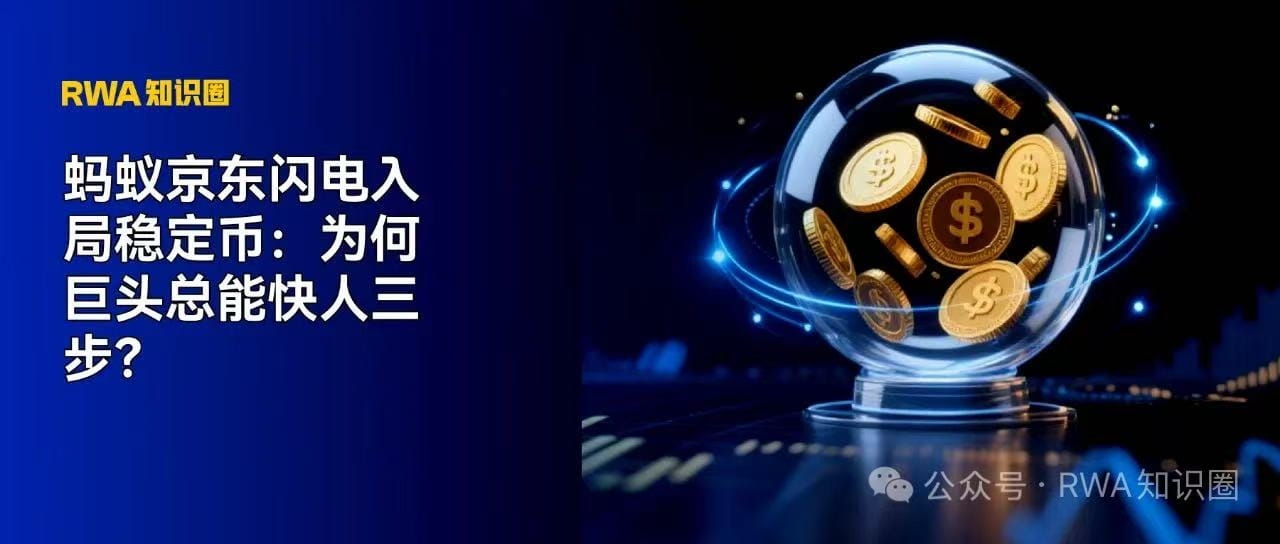
Written by | RWA Knowledge Circle
Compiled by | RWA Knowledge Circle
1. From Tether to Ant Group and JD, why have stablecoins become a battleground for giants?
In 2014, Tether issued the world's first stablecoin USDT, at a time when cryptocurrency was still a niche experiment. Eleven years later, in June 2025, JD and Ant Group announced their applications for Hong Kong stablecoin licenses, causing market upheaval. This is not a spur-of-the-moment decision—stablecoins have become core infrastructure in the field of RWA (Real World Assets tokenization), especially in scenarios involving cross-border trade, asset liquidity, and enterprise-level payments, where their value is being redefined by the market.
For B-end enterprises, the three major needs for stablecoins have emerged:
Reducing costs and increasing efficiency in cross-border payments: Traditional SWIFT cross-border settlements take 2-3 days, while blockchain-based stablecoins can achieve near-instantaneous transactions, reducing fees by over 70%;
Upgrading asset liquidity: On-chain funds for enterprises can be dismantled and combined in real-time, addressing mismatched payment terms;
Compliance-based digital asset management: Stablecoins anchored to fiat currency serve as the 'compliance passport' for enterprises entering the Web3 world.
2. The battle for positioning among giants: Policy sensitivity determines commercial opportunities.
Rome wasn't built in a day. While many B-end enterprises have not yet realized the commercial potential of stablecoins, tech giants like Ant Group have already laid out their strategies in advance based on policy evolution. Looking at the development context of Hong Kong (stablecoin regulatory framework), Ant's actions resonate with policy timelines:
2023: Hong Kong releases the world's first (stablecoin regulatory framework), and Ant immediately starts technical preparations;
April 2025: Ant Financial signs a contract with the Hong Kong government, establishing an overseas headquarters;
May 2025: Collaborating with HSBC to complete real-time allocation of tokenized deposits, validating on-chain settlement capabilities;
June 6, 2025: Hong Kong (stablecoin regulations) announced to take effect on August 1, and Ant announced the first batch of license applications on June 12.
This 'policy - technology - ecosystem' closed loop demonstrates the logic of stablecoins as a strategic pivot for the globalization of financial services by giants. Taking Ant International as an example, its three main businesses—Alipay+ (cross-border payments), Wanlihui (cross-border finance for SMEs), and Antong (merchant acquiring)—are naturally aligned with stablecoins. In 2024, out of over 1 trillion dollars in funds flowing through Ant International, 300 billion has already been processed via blockchain—if half of this were to migrate to its own stablecoin system, it would activate an endogenous trading volume of 150 billion dollars, equivalent to creating another cross-border payment giant.
3. Technological moat: How to support trillion-dollar enterprise-level applications?
Stablecoins are just the tip of the iceberg for RWA. A deep dive into Ant's technical architecture reveals that these investments hold significant insights for enterprises seeking compliant development.
High-performance trading engine: Layer2 blockchain Jovay designed for RWA, supporting 100,000 TPS and 100 milliseconds response time, a thousand times faster than Ethereum;
Developer ecosystem tool: Open-source virtual machine DTVM compatible with Ethereum, integrating AI framework SmartCogent, lowering development thresholds for enterprises;
Asset on-chain infrastructure: 'Two chains and one bridge' (AntChain asset chain + cross-chain bridge + Jovay) opens up the tokenization path for trillion-dollar physical assets like renewable energy.
Advancements in blockchain technology signify the entry of RWA into the 'millisecond-level trusted transaction' era—enterprises can complete complex operations like bulk energy trading and supply chain financing on-chain, with stablecoins becoming the 'blood' of these scenarios.
4. Breaking the deadlock for small and medium enterprises: the RWA track still holds golden opportunities.
As giants like Ant, JD, and Amazon seize the high ground, do small and medium enterprises have no opportunity? Absolutely not! The core value of RWA lies in the diversification of asset types and fragmentation of scenarios:
Sub-sectors like renewable energy, supply chain bills, and real estate are still blue oceans;
Customized stablecoin solutions are needed for scenarios like regional trade and vertical industry settlements.
However, SMEs must overcome three major hurdles:
License compliance: License applications in places like Hong Kong take 6-8 months and involve legal structures and reserve audits;
Technical architecture: On-chain issuance, custody, cross-chain integration, etc., with development costs exceeding one million dollars;
Ecosystem expansion: Challenges in building liquidity pools, merchant integration, and resource consolidation.
Professional institutions are becoming key drivers for breaking the deadlock, providing full-cycle support for SMEs: from designing the compliance paths for licenses from Hong Kong MAS to Singapore MAS, to lightweight development frameworks based on open-source tools like DTVM; from tokenization services interfacing with custodians like banks to precise ecological diversion in cross-border e-commerce scenarios, forming a closed-loop solution covering licenses, technology, capital, and market.
5. Stablecoins are the 'digital infrastructure revolution' for B-end finance.
From the heavy deployment by giants to the penetration of scenarios for SMEs, stablecoins are upgrading from 'cryptocurrency tools' to enterprise-level financial operating systems. With the Hong Kong (stablecoin regulations) taking effect in August, Chinese enterprises will welcome a new round of 'licensed competition.' For SMEs, achieving a 'compliance + technology + ecosystem' integration through systematic knowledge empowerment and resource connection presents a genuine opportunity to share in the benefits in scenarios such as cross-border trade and vertical industry chain finance—after all, the future of the digital economy is by no means a solo performance by the giants.





